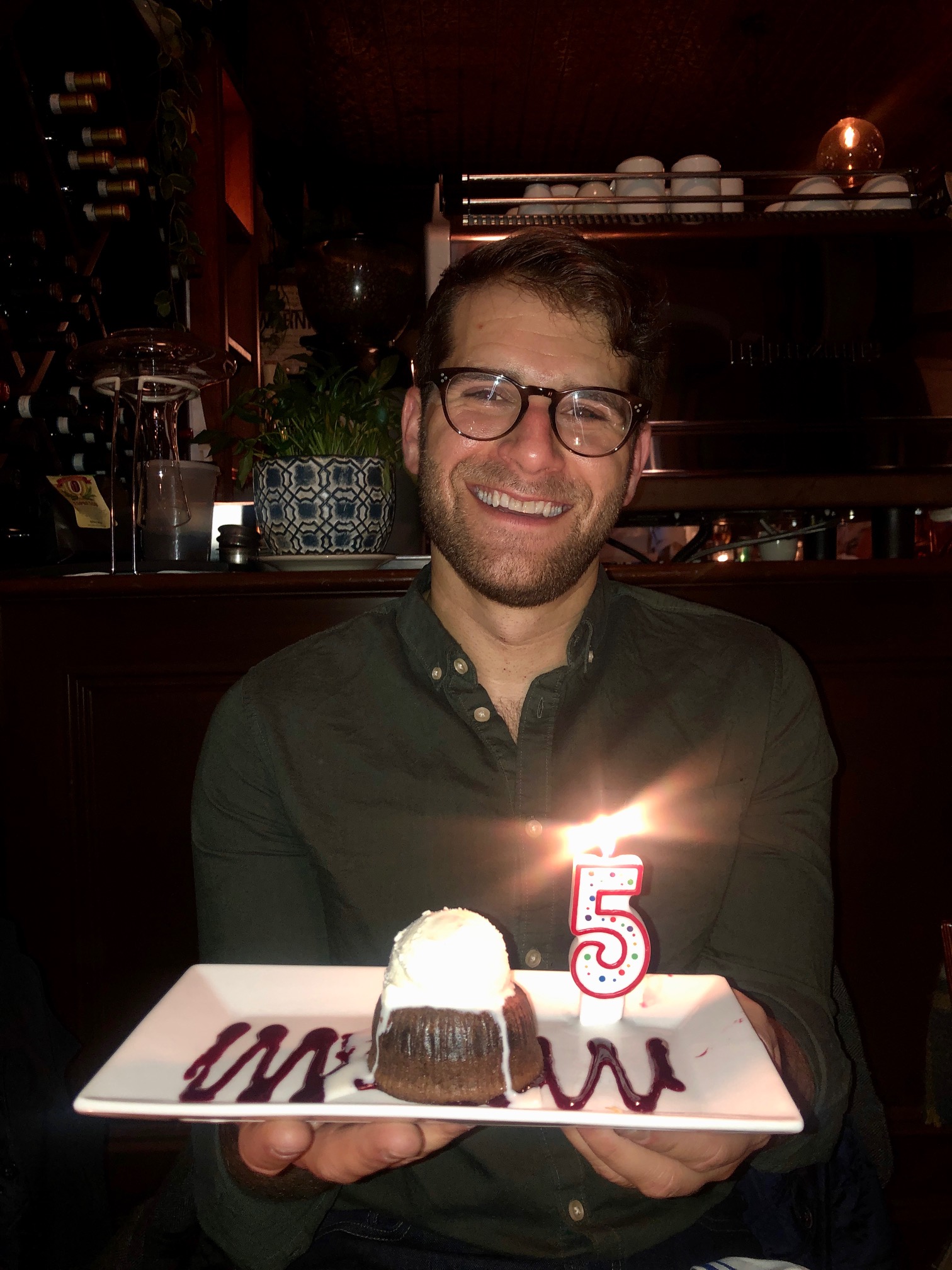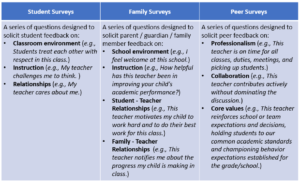Posts Tagged ‘Teacher Evaluation’
Collaborating to Examine Teacher Observation Rubrics for Equity
As an organization that strives to be anti-racist and to advance diversity, equity, inclusion and justice in our work, our Hendy team has taken a close look at our priorities and projects to determine how we can take steps to actively help create anti-racist schools. We believe that every organization should consider where they have influence and take strides to use their influence to proactively address racism, and teacher evaluation rubrics is ours.
As experts in teacher evaluation, and as an organization that frequently supports networks, districts and states to design and implement teacher evaluation rubrics, we identified rubrics as a place that we can advance equity with our clients. We know a lot about rubrics, both about how to write good rubrics, and how to implement rubrics to support teacher development and growth. And, we’ve been intentional about including language about inclusion and diversity in rubrics that we’ve helped to draft and implement. But we hadn’t yet taken an intentional look at rubrics to identify what in the language may be truly advancing equity in teaching and learning, and what might be hindering equity. We also knew that, as a team of four people who all identify as white, we have some critical blindspots in the work of examining tools with an anti-racist lens.
So, before we set out to create a tool, host a workshop, or even publish this blog post, we decided to do the work of examining rubrics ourselves. We contracted with two trusted leaders in Diversity, Equity, and Inclusion (DEI) in education, Carrie Ellis from Celestial Consulting and Ashley Griffin from Bowie State University and BEE Consulting, who themselves are women of color, and asked them to engage in this work with us. We also engaged Talia Shaull from Achievement First and Lisa Friscia from Democracy Prep, both members of Hendy’s Chief Talent Officer cohort, so we could have the perspective of practitioners in the field leading this work in their organizations. As a team we set out to examine the language of four teacher observation rubrics, two that are commonly used in districts and networks across the country, and two that are specific to networks we work closely with. Our intent was to identify specific examples of language, and overall trends in rubrics, that either supported or hindered efforts to advance equity and anti-racism. We also wanted to test a potentially transferable process for examining rubrics with an anti-racism lens.
We started the work by first affirming the role of rubrics in advancing equity and anti-racism in schools, and were honest about what rubrics can and can’t do. Then we examined the content of four rubrics to identify:
- Language or expectations in the rubric that values white dominant norms, values, and culture over those of other racial groups;
- Language in the rubric that is supportive of equity (specific practices, mindset cues for teachers, etc.); and
- Missed opportunities in the rubric to advance equity of instruction for students.
We organized and summarized the themes we saw in each rubric, and discussed those themes together to both align and clarify. In our discussion we surfaced several categories of content that might drive examination of other rubrics for bias and equity.
In addition to categories of content, we also discussed structural features of rubrics, and how those features may or may not advance equity. Specifically, we discussed student-focused vs. teacher-focused rubrics, and the inclusion of DEI as a separate indicator vs. baked in throughout all indicators.
Bringing together experts in different content areas to wrestle with a challenging question was engaging and frankly a lot of fun. We were able to push each other’s ideas, discuss what really matters, debate language and its impact, and learn and grow in the process. At the end of the day, our brains were tired, but we were energized by the ideas we created together and the possibility of sharing with others. We see a significant opportunity to improve rubrics and recognize that while doing so is insufficient for creating anti-racist schools, they do play a critical role in driving teacher practice and leaders’ coaching, and therefore must be improved.
Our work helped us to develop guidance that might support others who wish to examine their own teacher observation rubric, and inspired us to engage others in this work. We look forward to sharing that guidance in a webinar later this spring. If you or your team would like to engage in this work, please reach out. We all have a role to play in advancing anti-racism in our schools, and teacher evaluation rubrics can be a great place to start or continue efforts to ensure equity for all students.
Huge THANK YOU to Carrie, Ashley, Talia, and Lisa from all of the Hendy team!
Hendy Webinar Aug 5: Is your teacher evaluation system ready for Covid-19?
Ensuring that teachers feel safe, valued, and supported is at the heart of successfully reopening schools this fall. Development and evaluation systems can play a big role in defining the teacher’s experience and should be thoughtfully re-designed and communicated to meet those goals. The Hendy Avenue Consulting team has partnered with districts, states and CMOs to identify solutions to the tough questions around how to best develop and evaluate teachers in a remote or hybrid environment in a way that is consistent, fair, and supports teacher growth. We look forward to meeting with you and other system leaders to discuss the challenges, opportunities presented, and possible solutions for effectively supporting and evaluating teachers this year.
Please Join Us: Wednesday, August 5th at 4:00pm EST
REGISTER HERE!
Re-Thinking Teacher Development and Evaluation in 20-21: Facilitated by Hendy Avenue Consulting’s Jeremy Abarno and Sarah Rosskamm, please join other system leaders to learn how to approach teacher evaluation and development in a hybrid or remote environment and to connect with other system leaders in small group conversations and resource sharing.
From Puzzling to Problem Solving: My Growth Over Five Years at Hendy Avenue
My history with Hendy Avenue Consulting began at a coffee shop on the Lower East Side one afternoon in late 2014. I didn’t know what to expect, but thought it would be great to reconnect with Sarah, share a bit about what I had been up to professionally, hear about her work starting a consulting business and maybe, just maybe, start a conversation about how I could fit in the picture.
I couldn’t have imagined what was to come: five years at Hendy Avenue made up of great client partnerships, numerous high-impact projects impacting thousands of teachers, leaders and students, hundreds of hours video-conferencing, and a growing and tremendous team of colleagues and friends. We’ve built something special, and I couldn’t be more proud.
I’m so fortunate to work in an environment that not only supports professional (and personal) growth, but prioritizes it. It’s hard to narrow down, but here are four big lessons I’ve learned during my time at Hendy these last five years.
1. Take a Breath & Think
Prior to joining Hendy Avenue, my professional responsibilities consisted mostly of doing, rather than thinking. That’s not to say I did my work mindlessly, rather the focus and value-add of my contributions were grounded in producing materials, knocking things off a to-do list, and frankly working longer and harder than others. This efficiency-focused reality served me well in prior roles as a teacher and district administrator and during both stints in graduate school while working full-time. I thrived putting out fires and meeting tight deadlines–it was energizing. And look, I still love making and completing to-do lists, but the hyper-focus on efficiency limited the depth of my understanding of the tasks at hand, the quality of the ultimate end products, and the legacy of my work once I had moved on.
Now, as a more mature professional and seasoned consultant, I’ve retrained myself to take a breath and prioritize thinking as the real work, and as a result, my work is better, clients are happier and the impact on leaders, teachers and students is greater. Please know that This. Was. Not. Easy. (Sidenote: It’s still not easy). I was the archetype of young, type-A, overachieving, borderline obsessive, complete the task and your feelings be damned worker-bee. My own self-worth and value were tied-up in finishing the job. In fact, I remember early on into the role at Hendy just sitting at my desk with what felt like NOTHING to do. My inner-monologue wasn’t pretty: “I’m a waste. What value am I providing? Am I really doing anything to better serve students?”.
With time, and lots of other quiet moments, this role has shown me that yes, sometimes you need to put out that fire, but more often than not, we are brought into work precisely for our thinking, for our fresh and focused take on things made possible by the time and space we have as outsiders to pause, breathe, and think. When you’re treading water to stay afloat, you’re not best positioned to survey the ocean to find the route to safety. From the shore, surveying all that you can, the path becomes clearer.
I know now that my value-add is not just additional capacity–it’s asking tough questions, aggregating data, absorbing information, drawing from experience, guiding decision-making and making strong recommendations precisely because I intentionally hold sacred time and space to be strategic. So what can you do? Block time in your calendar for strategic planning/problem solving, journal or record a voice note of your questions and theories of the case, work with partners to pressure test ideas and most importantly, know your work and value are greater than a completed to-do list.
2. Build Comfort in Ambiguity
With all that time and space to think, you’d imagine the answers come easily. Sometimes, that’s true–we can identify a problem and name the best solution after a quick introductory call with a client. But usually, even if the answer is clear, the route to success is cloudy. Organizations are complicated, even the best ones; look under the hood and something, somewhere is a #hotmess–it’s the nature of people working together.
Five years ago, when confronted with a less than clear road forward, I would have likely either (1) built a quick plan based on instinct or (2) retreated from taking a position and deferred to others, not yet confident to survive the painstakingly vulnerable moment of someone publicly disagreeing. If ambiguity persisted, I would feel like a failure, thinking I was not providing my clients what they needed, deserved, and for some reason, were paying for!
With time, I’ve learned to sit with ambiguity, become less judgmental about it, acknowledge it, respond to it, and sometimes leverage it as an opportunity. This comfort didn’t happen overnight; in many regards, it’s grown alongside my work (and persistence) with clients.
As I’ve wrestled with making decisions within confusing and changing contexts, a few tried and true techniques have proven fruitful:
- Return to the overarching purpose and big goals: Start projects with a clear, compelling goal. Knowing what success looks like will help you make decisions that drive toward that end goal, keeping you on track, even when the view ahead is blurry.
- Assess the current moment in time within the larger lifespan of the project: Is this truly critical? Where are we in the scope of big decisions to be made? What are the implications of moving quickly/slowly? What’s within our locus of control that we can act on now?
- Consider all the possible theories of the case: In any confusing situation, there are many potential causes and solutions. Push yourself to see the situation from multiple points of view, pressure test theories with colleagues and game out possible paths forward, considering the pros/cons for all stakeholders.
- Pessimistically plan: Intentionally think about likely obstacles then developing ideas for how to pre-empt or respond.
3. Invest in Relationships
If you couldn’t already guess, I love a good project plan; I live for a beautiful Excel spreadsheet. But it has been obvious over the past five years that relationships, not these tools, make the work happen and achieve success.
On one hand, our ability to analyze data, review policy, design communications, and make recommendations rests on knowing the stakeholders involved—their interests, expertise, passions and limitations—which can’t live on a spreadsheet.
Second, and maybe more important, this work is really personal–it’s about kids’ and their life opportunities. I think about my former students every day; my heart still aches for the pain they felt 10+ years ago when they fell on the playground and I remember joyfully the smile that came across their face after reading aloud their own writing during a publishing party. So many of our clients and partners have similar driving memories–of past students or their own children–making our work to better teaching and learning incredibly meaningful and high-stakes.
Talent development programs too are incredibly personal. The average American spends 90,000 hours at work over their lifetime. So much of our identity and self-worth is tied up in our jobs. As anyone who has lived in New York City knows, the most common question you’re asked after meeting someone is: “what do you do?” As a result, any efforts to define, develop and reward excellence at work can strike at the core of who we are and how we feel.
Here are four strategies for building and maintaining relationships that I’ve found to be helpful:
- Be authentically yourself. One, you deserve to always be your true self. Two, you’re always modeling behavior for others, so set and hold the expectation. Three, people like other people who are comfortably themselves; think about a time you disagreed with someone, you probably continued to respect them if you sensed they were being honest. If you felt like they were trying to game the system or play politics, you probably don’t want to re-engage with that person unless you have to, regardless of the content of their opinion.
- Be intentional about knowing people, especially when working virtually/at a distance. Building strong relationships won’t just happen. Think about ways you can plan routines and systems that are inclusive, review how your time is spent and with who, audit the airtime of folks in meetings, and reference the accomplishments of others. Know the names of your client’s kids. Ask about upcoming plans to travel to Mexico. In other words, be a real person at work. I can’t encourage this enough, but take notes–you probably do during all other work meetings and engagements–why not now? I’m horrible at remembering names and worse with birthdays and anniversaries, so instead of not knowing, I write them down. My Outlook calendar is a color-coded Rosetta Stone for my life, and the 10 seconds it takes to set a recurring reminder for someone’s birthday goes a long way in showing colleagues and clients that I value and care about who they are.
- Make yourself part of the team. It can be difficult to feel part of the team when you’re (1) external to the organization (2) not physically situated with others and (3) present for some, but not all key meetings and events. Teams may not sit in Office Space-style cubicles and have to write TPS reports anymore, but so much of a group’s culture building happens around the proverbial water cooler. So what can you do?
- Do your homework and know what’s happening in town: the weather, the hot new restaurant opening, the big game that weekend; all are great for making yourself part of the team. Pro-tip: set up Google alerts!
- Make a concerted effort to learn and use the language used by your clients: Are they students or scholars? Principals or School Leaders? What’s the funky acronym for their central office teams? These little cues help you meld into the team and live in their world comfortably, even if it’s only for a few hours a week.
- When possible, invest time (and money) in being physically present: go to team happy hours and lunches; join weekly team meetings and spend a day working from the office–you may even be there for the creation of a lasting inside joke.
- Be vulnerable, appropriately. Vulnerability is hard for many of us, especially achievement-oriented, type-A folks who lead teams. We’ve been (unfortunately) conditioned to think that we must be confident, direct and all-knowing at all times or face the wrath peers who hold you in low regard. Not only does this limit our ability to be authentic and build relationships, it presents a damaging model for colleagues who are likely to replicate your behavior. Take the risk and be vulnerable when the moment calls for it. This could look like telling a deeply personal story about why the project you are leading is meaningful to you or sharing lessons learned from a time you failed miserably. Keep in mind however that the benefits of vulnerability have limits, and efforts must stay within the standards of your professional context. I don’t encourage starting all meetings with a trust fall exercise or co-opting a team retreat to complain about your neighbor’s dog. Instead, productive vulnerability humanizes you and connects to the work.
4. Implementation > Design
Talent leaders often spend so much time working to craft “perfect” rubrics, surveys, rewards and retention techniques. While these factors matter a great deal, they are usually not the tipping points between success and struggle. What matters more is the depth, breadth and quality of implementation.
This reality comes up most when I think about projects that fell short of their intended outcomes. Did I spend my time wisely? How well did I prioritize building internal capacity and skill to execute? With one client team for example, we had some of our best plans and meetings, smartest designs, and the beginnings of strong relationships with stakeholders across the organization. I honestly re-use some of the content from those evaluation design meetings because I think they were our strongest to-date. And yet, we had to pause, then end the project early, well-before we had met the intended outcomes because internal capacity was not there.
As we stew on how to find the right balance, here are a few recommendations for successful implementation:
- Over communicate the why: you can never, never, never over-communicate the rationale for programs and decisions. For those in the work daily, the outcomes we seek can be obvious and the rationale behind decisions clear. But for most, especially folks on the receiving/participatory end of our projects, they have thousands of other things to worry about and therefore need to be constantly brought back to the overarching purpose and compelling reason for the program/change/initiative you are leading.
- Start from the ground up: this could also be called, “don’t make assumptions”. It is easy to make generalizations about what stakeholders want, whether it be a firm’s employee value proposition, retention strategy, or compensation model. Yes, you should read what Vox says about Millennials in the workplace or Gallup’s best methods for responding to Q12 survey data—those are helpful, but as a floor, not the ceiling. The best outcomes stem from going directly to the source, the end users or folks who will be impacted by the policies and programs we manage and asking, “What do you want?” “Would this be meaningful?” “What matters most/least?”
- Pilot, pilot, pilot: Everyone underestimates the lift required to successfully implement a change. I can’t count the number of times a C-level leader has said, “we’re really good at instructional coaching” or “our data systems are strong” to only have that same strength become THE roadblock to success. The key to avoid this trap is investing the time, resources, energy and attention to robust piloting. There is no better way to learn what will and won’t work than testing within your context. Do it early and often.
So what now? While the field always moves forward, systems change over time and life circumstances always bring surprises, the one constant is the opportunity to grow and develop. I’ll just have to keep learning. Here’s the next five years and all to come that can’t even be imagined. -Grant

Designing Systems to Limit the Impact of Bias
In March, we wrote about how coaches and evaluators must identify, then set aside, biases in order to fairly and accurately evaluate and develop teacher practice. This critical work by individuals is powerful, but not the only tool available to leaders and policy makers in reducing bias: Specific design elements within performance management systems can help reduce opportunities for bias to impact results.
Drawing upon findings from the MET Study and our practical experience with school systems across the country, we recommend three design features to limit biases:
- Balance with multiple measures: Evaluations that rely on a single input are not only more vulnerable to year-over-year volatility but they present the greatest opportunity for evaluator bias to impact outcomes. Consider, for example an evaluation system with one input, ratings on a common teaching rubric. As evaluators work to determine ratings, their biases can (and will) creep in. Without a second or third objective measure to balance the overall evaluation, the teacher’s rating is subject to the influence of these biases with no checks or balances.
- Utilize multiple observers/evaluators: As with multiple measures, adding additional observers/evaluators increases statistical reliability (reliability = overall consistency of a measure). MET Study authors write: “When the same administrator observes a second lesson, reliability increases from .51 to .58, but when the second lesson is observed by a different administrator from the same school, reliability increases more than twice as much,from .51 to .67.” While districts must wrestle with the best allocations of limited time and resources, there is great benefit to having a second set of eyes on a teacher’s performance.
- Use outcomes-based tools: Many common evaluation instruments measure inputs–the actions taken toward a goal–rather than assessing the desired outcomes. Unfortunately, measuring inputs can yield false positives: a teacher can try a specific approach and receive high marks, even if the strategy fails to produce appropriate student learning. Instead, strong evaluation systems use outcomes-based tools and rubrics that identify observable and measurable behaviors. For example, we’re big fans of the Core Teaching Rubric, which describes with specific language what students are saying and doing at different levels of performance–rather than teacher actions–so that observers can evaluate performance based on what matters most: student experience and learning. By focusing on student outcomes, there is less risk of observers inserting their biases or preferences for a particular instructional strategy. Instead, an outcome-based tool focuses observers on what and how students are learning, which is what matters the most.
While these structural changes alone will not eliminate bias, they can make a big difference. What have you seen be successful in reducing bias in performance management? Let us know in the comments!
Three Lessons for Meaningful Performance Management Incentives
We’re big fans of performance management. We know that for people to achieve their best, they need clear definitions of excellence, resources and tools to achieve that benchmark, and frequent, action-oriented feedback that drives their development. Too often, however, organizations don’t know how to link performance management efforts with valuable incentives for their talent.
Before we dig in, let’s get one thing out of the way: incentives in the workplace are not inherently good or bad. Done well, incentives can be a powerful tool for motivation, recognition and reward. Done poorly, incentives can lead people to feel controlled or set up for failure.
Incentives come in all shapes and sizes but most fit within one of the five Rs:
- Rewards: salary, incentives, bonuses, benefits
- Responsibilities: variety, autonomy, challenge, promotions, learning
- Relationships: coworkers, supervisors, clients, and customers
- Reputations: image, respect, appreciation, feedback
- Rest & Relation: hours, scheduling, flexible, travel, location
So what now? Maybe you want to give a bonus to high-performers, grant newcomers more autonomy or show appreciation to employees who routinely go above and beyond. In any situation, here are three recommendations to help you build a foundation for offering incentives:
- Set achievable, meaningful, and controllable benchmarks for employees. Ambitious goals are great but they should not be impossible to reach. Similarly, desired outcomes must matter to the person and organization. If mission driven, make clear the connection between the individual’s impact and how it helps the the organization get closer to their vision. It may seem obvious, but people also have to know that what they will be measured against can be reached by the levers within their control. We would never evaluate a bank teller by the number of light bulbs that need to be changed monthly, so test your goals to ensure a direct line back to employee actions and responsibilities.
- Know what people want. A huge problem is that organizations generally don’t know what their people want. For example, leaders may assume everyone is motivated by the same things or rely too heavily on what has historically been motivating. Particularly in large or longstanding organizations, there is too much application of the golden rule (treat others as you want to be treated) by decision-makers and not enough of the platinum rule (treat others as they want to be treated). There’s no secret to fixing this problem; you need to do your research (e.g., ask employees, read research on generational shifts, talk to industry leaders) and pilot before full-scale launch. The best approaches customize incentives for specific groups or individuals.
- Keep support and growth at the center. Earning an incentive should not be the end of the journey for your employees. Milestones are important, but should always be coupled with a “what’s next?” conversation so that people feel you are genuinely invested in their growth and development (which we hope you are!) and can tangibly see the road ahead. If one does not yet exist, take the opportunity to co-create. A common pitfall is focusing too much on monetary or extrinsic rewards, sometimes to the detriment of strong intrinsic motivators. Focusing on continual improvement and long-term development will help mitigate this risk.
How have you effectively implemented incentives? What’s been the most interesting outcome? Sound off in the comments below!
Listen Up: Hendy Avenue on EdPOP Podcast
Curious to learn more about Hendy Avenue Consulting? Our very own Jessica Wilson sat down with the host of EdPOP to talk about our mission, recent projects and how talent strategy can make the difference for kids across the country.
Three Steps to Avoid Common Observation Biases
We all have biases. Whether picking an ice cream flavor or choosing to take the scenic route rather than the highway, we all operate with mental models that place disproportionate weight on certain factors that move our judgment in favor of one option when compared to another.
When observing and evaluating teacher practice, there are numerous opportunities for biases to creep in. Just think of all the factors that go into a lesson: the subject, grade, school, teacher, time of day, lesson structure, materials used and more. An observer may think to themselves, “the students were well-behaved for the first class right after lunch”. A different person observing that same lesson may think, “if I was teaching this class, I would have used a different text.” Both of these sentiments may be true, but they have to be placed aside before conducting a visit so that observers can focus on objective teacher and student actions.
In short, great observers, coaches, and evaluators must identify, then set aside, biases in order to fairly and accurately evaluate and develop teacher practice.
Common biases include:
- Confirmation bias: the tendency to search for or interpret information in a way that confirms one’s preconceptions,
- Halo effect: the tendency for a person’s positive or negative traits to “spill over” from one area of their personality to another in others’ perceptions of them, and
- Mirror bias: the tendency to judge performance as “good” if it is “like I would have done it.
A full table of common observer biases with examples can be found here: Observer Bias Examples
In order to mitigate the impact of these biases, great observers should ask themselves three questions:

Five Lessons for Decision-Making
Making decisions is hard (just ask my husband how many rugs I’ve looked at for our living room). It’s even harder when those decisions will have a real impact on students, teachers and school leaders. Yet working with school system leaders across the country, it’s become very clear to us that how organizations make decisions has a huge impact on the success of their initiatives and of their organization overall. A few things we’ve learned:
1. Choose one final decision-maker. We all like the idea of consensus. We want to believe if we discuss ideas thoroughly, eventually we will come to a clear answer everyone believes in. Unfortunately, that lofty goal can instead lead to delays, frustration and in the end, no clear decision. Before diving into a project, leaders need to very clearly identify who is the final decision-maker for each key decision. The decision-maker should have input from as many stakeholders as possible in order to make the best possible decision, but at the end of the day, he or she has to make a final call.
2. It doesn’t have to be the head honcho. The most effective organizations we’ve seen delegate not only work, but also decision-making. For example, we work with a great organization where the CEO trusts the Chief Talent Officer to make smart decisions. He also trusts her judgment to bring particularly difficult decisions to him to discuss and decide together. As a result, the Chief Talent Officer is invested, feels ownership over her work, and makes things happen quickly. She’s not bottlenecked by a lengthy decision-making process when it isn’t necessary and because she’s closer to the work, is able to make great decisions. As leaders, consider who is best positioned to make the right call and institute a path for escalation when necessary.
3. There isn’t a right answer. Sorry to break it to you, but unfortunately there is not always a right answer. There is only the best possible decision given the available information. We’ve seen leaders in decision paralysis because they are afraid to make the wrong decision; instead, they repeatedly to ask for more and more information to delay their decision. As a result, there is less time for planning, communications, change management and implementation (all of which are often equally if not more important than the decision being made). The overall success of the work is damaged when decisions are delayed unnecessarily.
4. Once a decision is made, all leaders must rally behind it. Behind closed doors, share concerns candidly and fight it out. But once a decision is made, all leaders must present a united front to support the decision. Nothing hurts credibility of a decision more than a leader questioning a decision publicly.
5. Decisions must be tested and can be changed. The good news is that most decisions are not forever. With changing environments, new information or different players, things will always need to evolve. We encourage our partners to thoroughly pilot their initiatives and to use that new information to improve their decisions in the best interest of teachers, leaders and students.
Making decisions is hard, but there are ways to make smarter, better decisions. What lessons have you learned about making decisions? Sound off in the comments.
-Sarah
Put Excellence at the Heart of Performance Management
Performance management, at its core, sets expectations. It puts a stake in the ground for what “good” looks and sounds like in the classroom and serves as the baseline of teacher observation rubrics. Effective performance management is more than diagnosing current performance; it supports teachers to articulate an actionable, clear trajectory toward excellence. Ultimately, a vision of good teaching and learning must be at the heart of any performance management system.
Common Pitfall: Framework Without Vision
Too often schools and districts launch a performance management system by creating or selecting a rubric without consideration of core instructional priorities. Enthusiasm and urgency, while helpful, can lead to less than ideal system design.
For example, simply adopting an existing framework because it is “proven” or “research-based” might not actually lead schools and teachers to excellence: what might be excellent teaching in one context might not be true in another setting. Creating a framework from scratch in a vacuum, separate from instructional priorities, isn’t likely to lead teachers to excellence either.
This doesn’t mean that adopting an existing framework is the wrong strategy, or that creating something new won’t get leaders and teachers where they need to be. It does mean, though, that this work must be grounded in the core realities of instruction necessary to move kids.
Ground Performance Management in a Vision for Excellent Instruction
Co-design and co-own by instructional leaders. Defining excellence for as complex a role as teaching requires a team of individuals, with different areas of expertise and focus. While very often, the development of teacher evaluation systems lives within talent/human resources, great systems strategically draw in additional stakeholders. For quality operations, a talent leader should drive and own the design and implementation of a performance management framework. At the same time, this work should be a shared priority between leaders of talent, academics and school management functions in a network or district. Instructional leaders working in schools daily must be the core authors and implementers of expectations for teachers.
Measure what matters. If teachers are held to expectations through a framework that aligns with core instructional priorities, schools are more likely to see improvement in the areas that matter most for students. If a solid instructional vision grounds all decision making, then curricular resources, training, and other supports will naturally stem from that vision. As teachers are supported to meet expectations via appropriate the resources, materials, and training, student learning will flourish.
Lead from your vision. Consider the following questions, and strategically engage others to ensure answers reflect the perspectives of a broad range of stakeholders:
- What are our prevailing beliefs within our system about students, and the role teachers play in their success?
- What do the instructional standards require from our students? And then, by extension, from our teachers?
- In classrooms where good teaching and learning is happening, what are teachers doing? What are students doing?
- How does this differ for different students? Different contexts?
- How do we ensure that the performance management system we design reflects our vision of excellent teaching?
- Who will own this work? How will we ensure that leaders from talent and instruction both continue to be involved?
Let us know what you think in the comments below!
-Jessica
Designing Evaluation Frameworks with Development at the Core – Part III: Amplifying Stakeholder Voice with Surveys
This post is the third in a series on how innovators are reimagining the design and implementation of evaluation and development frameworks. Read our earlier posts on observation frequency and raising rubric rigor.
When you think of a teacher, where are they? What are they doing? If you envisioned someone standing in front of a blackboard, lecturing a group of students, you’re likely not alone. In reality however, teachers spend their days in a multitude of ways: working individually with students, collaborating with peers, planning independently, connecting with parents and family members.
Definitions of excellent teaching therefore must go beyond classroom observations and measures of student outcomes (both of which are important!), to gather a broader view of a teacher’s impact.
Surveys are a simple, yet powerful tool that can amplify the voices of stakeholders from across a school community to help educators develop a comprehensive view of excellence.
The Benefits of Administering Surveys
- Surveys, coupled with other measures like classroom observations, provide rich information to help teachers improve their practice. Teaching is a complex job that depends on strong relationships. While districts and schools have made progress in collecting data and providing feedback on certain aspects of the profession (e.g., content knowledge, teaching strategies, assessment data), our field often misses the opportunity to coach teachers on their relationship building with students, families and peers.
- Research says that students are reliable evaluators of a teacher’s impact. Analysis by the Measures of Effective Teaching (MET) project finds that teachers’ student survey results are predictive of student achievement gains. In other words, students know an effective classroom when they experience one.
- Surveys provide the opportunity to put values into practice. Value statements like “we are a team and family” or “parents are partners” are powerful; however, these beliefs are only as true as the actions taken to build an authentic community. Administering surveys of key stakeholders sends a strong message that the voices of community members are valued, respected and heard.
- Surveys provide clear and transparent expectations to teachers. When questions are shared with teachers in advance, the survey content provides clear definitions for expected behaviors in teacher-to-teacher, teacher-to-student, and teacher-to-family relationships. For example, if a survey asks families if they receive one or more positive phone calls a month from their child’s teacher, that sets a very clear expectations for the teacher-family relationship.
Survey Types
Educators have available a number of survey types, structures, question formats and administration platforms.The table below highlights three common survey types.
Surveys should be designed thoughtfully, taking into consideration the purpose, audience, and respondents.
- Purpose – Why are you administering the survey? What do you hope to learn? How will results be utilized?
- Audience – Who will analyze and interpret the survey results? When and how will they reflect on and plan from the results? How will the results be debriefed with teachers to improve practice?
- Respondents – Who will complete the survey? When and how will they complete the survey? What directions, supports and technology will be necessary for administration?

To learn more, including a list of sample survey questions, visit the resources page of our website.









